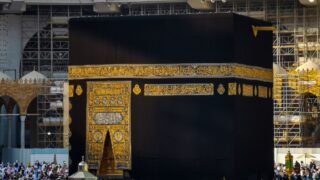There are Three Forms of Hajj:
- Tamattu’
- Ifraad
- Qiran
Tamattu’: A pilgrim wears Ihram for Umrah only during the months of Hajj, which means that when he reaches Mecca, he makes Tawaf and Sa’i for Umrah. He then shaves or clips his hair. On the day of Tarwiya, which is the eighth of Dhul-Hijjah, he puts on his Ihram for Hajj only and carries out all of its requirements.
Ifraad: A pilgrim wears Ihram for Hajj only. When he reaches Mecca, he performs Tawaf for his arrival and Sa’i for Hajj. He doesn’t shave or clip his hair, as he doesn’t disengage from Ihram. Instead, he remains in Ihram till after he stones Jamrah Al-Aqaba on the Eid day. It is permissible for him to postpone his Sa’i for Hajj until after his Tawaf for Hajj.
Qiran: A pilgrim wears Ihram for both Umrah and Hajj or he wears Ihram first for Umrah, and then makes intentions for Hajj before his Tawaf for Hajj. The obligations on one performing Ifraad are the same as those on one performing Qiran, except that the latter must slaughter whereas the former is not obligated to do so. The best of the three forms is Tamattu’. It is the form that the prophet (may the peace and blessings of Allah be upon him) encouraged his followers to perform. Even if a pilgrim makes intentions to perform Qiran or Ifraad he is allowed to change his intentions to Tamattu’; he can do this even after he has performed Tawaf and Sa’i.
When the Prophet (may the peace and blessings of Allah be upon him) performed Tawaf and Sa’i during the year of the Farewell Hajj with his companions, he ordered all those who hadn’t brought sacrificial animals to change their intentions for Hajj to intentions for Umrah, cut their hair, and disengage from Ihram till Hajj. He said, “If I hadn’t brought the sacrificial animal, I’d have done what I’ve ordered you to do.”

















